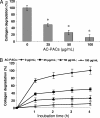Anti-Porphyromonas gingivalis and anti-inflammatory activities of A-type cranberry proanthocyanidins
- PMID: 20176905
- PMCID: PMC2863644
- DOI: 10.1128/AAC.01432-09
Anti-Porphyromonas gingivalis and anti-inflammatory activities of A-type cranberry proanthocyanidins
Abstract
A-type cranberry proanthocyanidins (AC-PACs) have recently been reported to be beneficial for human health, especially urinary tract health. The effect of these proanthocyanidins on periodontitis, a destructive disease of tooth-supporting tissues, needs to be investigated. The purpose of this study was to investigate the effects of AC-PACs on various virulence determinants of Porphyromonas gingivalis as well as on the inflammatory response of oral epithelial cells stimulated by this periodontopathogen. We examined the effects of AC-PACs on P. gingivalis growth and biofilm formation, adherence to human oral epithelial cells and protein-coated surfaces, collagenase activity, and invasiveness. We also tested the ability of AC-PACs to modulate the P. gingivalis-induced inflammatory response by human oral epithelial cells. Our results showed that while AC-PACs neutralized all the virulence properties of P. gingivalis in a dose-dependent fashion, they did not interfere with growth. They also inhibited the secretion of interleukin-8 (IL-8) and chemokine (C-C motif) ligand 5 (CCL5) but did not affect the secretion of IL-6 by epithelial cells stimulated with P. gingivalis. This anti-inflammatory effect was associated with reduced activation of the nuclear factor-kappaB (NF-kappaB) p65 pathway. AC-PACs may be potentially valuable bioactive molecules for the development of new strategies to treat and prevent P. gingivalis-associated periodontal diseases.
Figures






Similar articles
-
Cranberry proanthocyanidins act in synergy with licochalcone A to reduce Porphyromonas gingivalis growth and virulence properties, and to suppress cytokine secretion by macrophages.J Appl Microbiol. 2012 Aug;113(2):438-47. doi: 10.1111/j.1365-2672.2012.05329.x. Epub 2012 May 31. J Appl Microbiol. 2012. PMID: 22563853
-
Cranberry proanthocyanidins inhibit the adherence properties of Candida albicans and cytokine secretion by oral epithelial cells.BMC Complement Altern Med. 2012 Jan 16;12:6. doi: 10.1186/1472-6882-12-6. BMC Complement Altern Med. 2012. PMID: 22248145 Free PMC article.
-
Highbush blueberry proanthocyanidins alleviate Porphyromonas gingivalis-induced deleterious effects on oral mucosal cells.Anaerobe. 2020 Oct;65:102266. doi: 10.1016/j.anaerobe.2020.102266. Epub 2020 Aug 29. Anaerobe. 2020. PMID: 32871243
-
Cranberry proanthocyanidins: natural weapons against periodontal diseases.J Agric Food Chem. 2012 Jun 13;60(23):5728-35. doi: 10.1021/jf203304v. Epub 2011 Nov 29. J Agric Food Chem. 2012. PMID: 22082264 Review.
-
Cranberry polyphenols: potential benefits for dental caries and periodontal disease.J Can Dent Assoc. 2010;76:a130. J Can Dent Assoc. 2010. PMID: 20943032 Review.
Cited by
-
Efficacy of Proanthocyanidins from Pelargonium sidoides Root Extract in Reducing P. gingivalis Viability While Preserving Oral Commensal S. salivarius.Materials (Basel). 2018 Aug 22;11(9):1499. doi: 10.3390/ma11091499. Materials (Basel). 2018. PMID: 30135370 Free PMC article.
-
Proanthocyanidins and Flavan-3-ols in the Prevention and Treatment of Periodontitis-Immunomodulatory Effects, Animal and Clinical Studies.Nutrients. 2021 Jan 15;13(1):239. doi: 10.3390/nu13010239. Nutrients. 2021. PMID: 33467650 Free PMC article. Review.
-
The effect of cacao bean extracts on the prevention of periodontal tissue breakdown in diabetic rats with orthodontic tooth movements.J Oral Biol Craniofac Res. 2024 Jul-Aug;14(4):384-389. doi: 10.1016/j.jobcr.2024.05.013. Epub 2024 May 24. J Oral Biol Craniofac Res. 2024. PMID: 38832299 Free PMC article.
-
Cranberry Flavonoids Modulate Cariogenic Properties of Mixed-Species Biofilm through Exopolysaccharides-Matrix Disruption.PLoS One. 2015 Dec 29;10(12):e0145844. doi: 10.1371/journal.pone.0145844. eCollection 2015. PLoS One. 2015. PMID: 26713438 Free PMC article.
-
Inhibition of gingipains and Porphyromonas gingivalis growth and biofilm formation by prenyl flavonoids.J Periodontal Res. 2017 Feb;52(1):89-96. doi: 10.1111/jre.12372. Epub 2016 Mar 9. J Periodontal Res. 2017. PMID: 26957413 Free PMC article.
References
-
- Andrian, E., D. Grenier, and M. Rouabhia. 2006. Porphyromonas gingivalis-epithelial cell interactions in periodontitis. J. Dent. Res. 85:392-403. - PubMed
-
- Bavington, C., and C. Page. 2005. Stopping bacterial adhesion: a novel approach to treating infections. Respiration 72:335-344. - PubMed
-
- Bodet, C., F. Chandad, and D. Grenier. 2006. Anti-inflammatory activity of a high-molecular-weight cranberry fraction on macrophages stimulated by lipopolysaccharides from periodontopathogens. J. Dent. Res. 85:235-239. - PubMed
-
- Bodet, C., D. Grenier, F. Chandad, I. Ofek, D. Steinberg, and E. I. Weiss. 2008. Potential oral health benefits of cranberry. Crit. Rev. Food Sci. Nutr. 48:672-680. - PubMed
Publication types
MeSH terms
Substances
Grants and funding
LinkOut - more resources
Full Text Sources
Other Literature Sources

